Abstract
The folding kinetics of a truncated form of the N-terminal domain of phage lambda repressor [lambda 6-85] has been investigated by using the technique of dynamic NMR. lambda 6-85 has been shown previously to fold in a purely two-state fashion. This allows the determination of folding and unfolding rates from simulation of the exchange-broadened aromatic resonances of Tyr-22. The folding kinetics were determined over a range of 1.35 to 3.14 M urea. The urea dependence of both folding and unfolding rate constants is exponential, suggesting that the rate-determining step is invariant at the urea concentrations studied. The folding and unfolding rates extrapolated to 0 M urea at 37 degrees C are 3600 +/- 400 s-1 and 27 +/- 6 s-1, respectively. The observed lambda 6-85 folding rate constant exceeds that of other fast-folding globular proteins by a factor of 14-54. The urea dependence of the folding and unfolding rate constants suggests that the transition state of the rate-determining step is considerably more exposed to solvent than previously studied protein-folding transition states. The surprising rapidity of lambda 6-85 folding and unfolding may be the consequence of its all-helical secondary structure. These kinetic results clearly demonstrate that all of the fundamental events of protein folding can occur on the submillisecond time scale.
Full text
PDF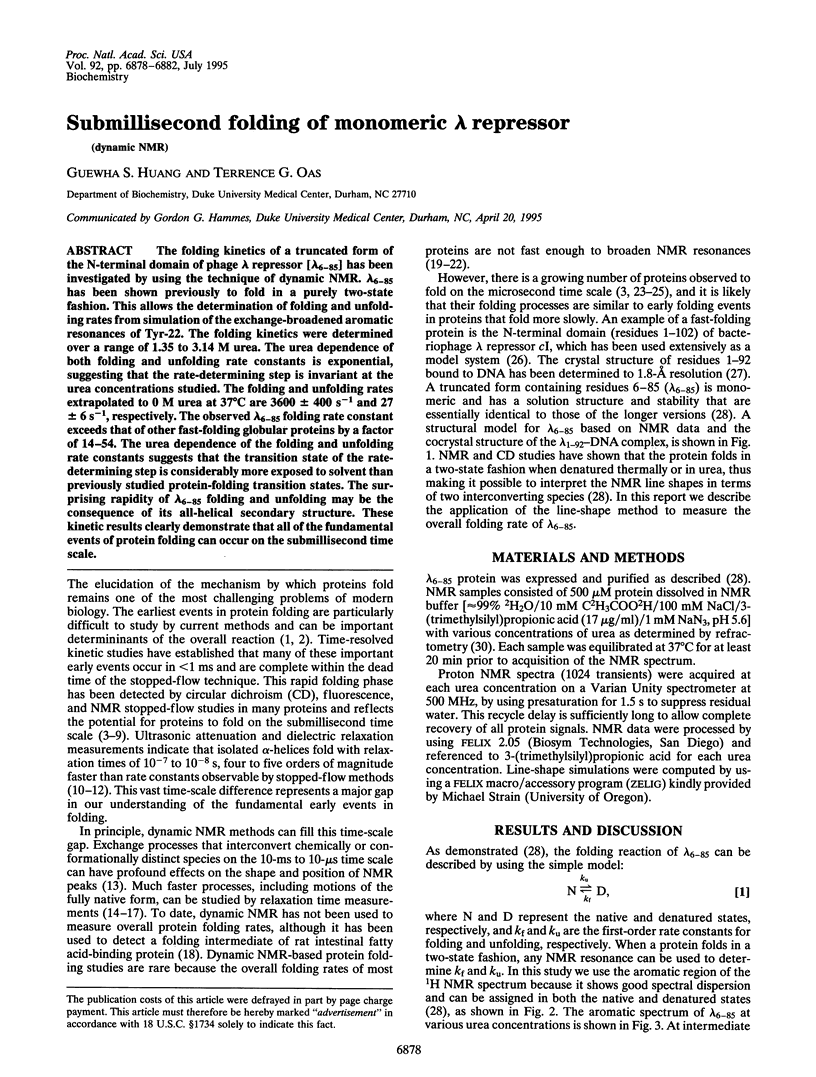
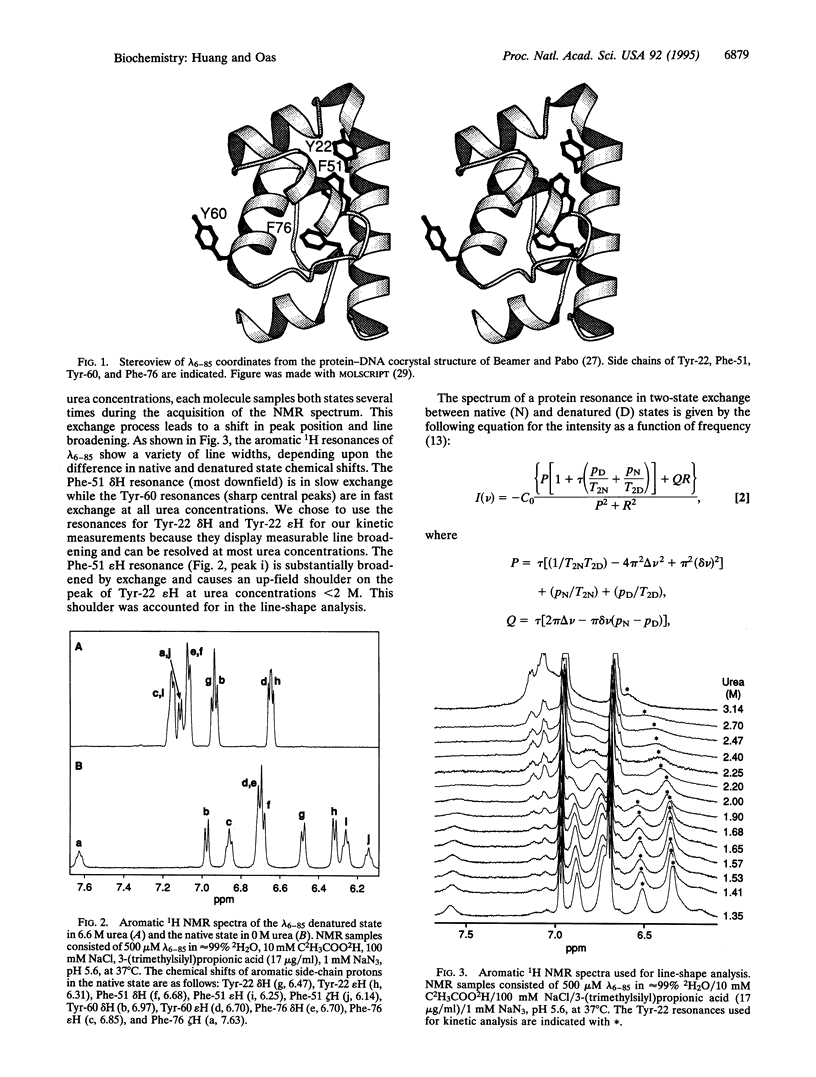
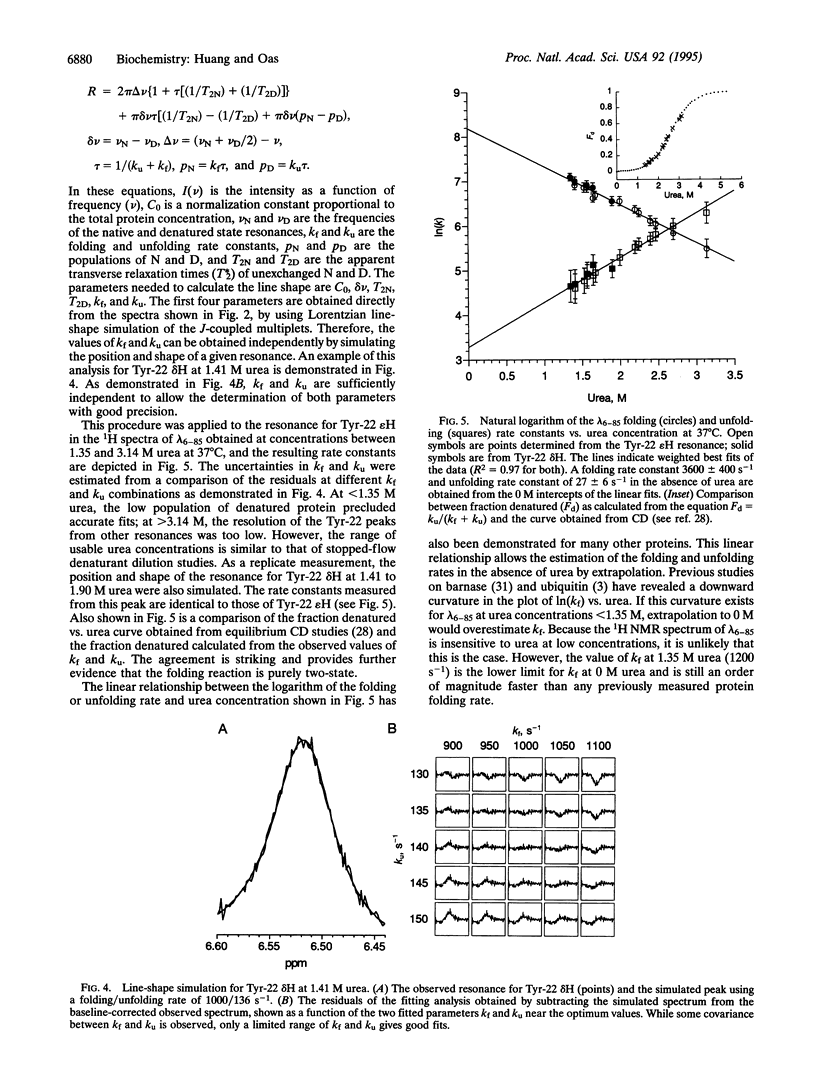
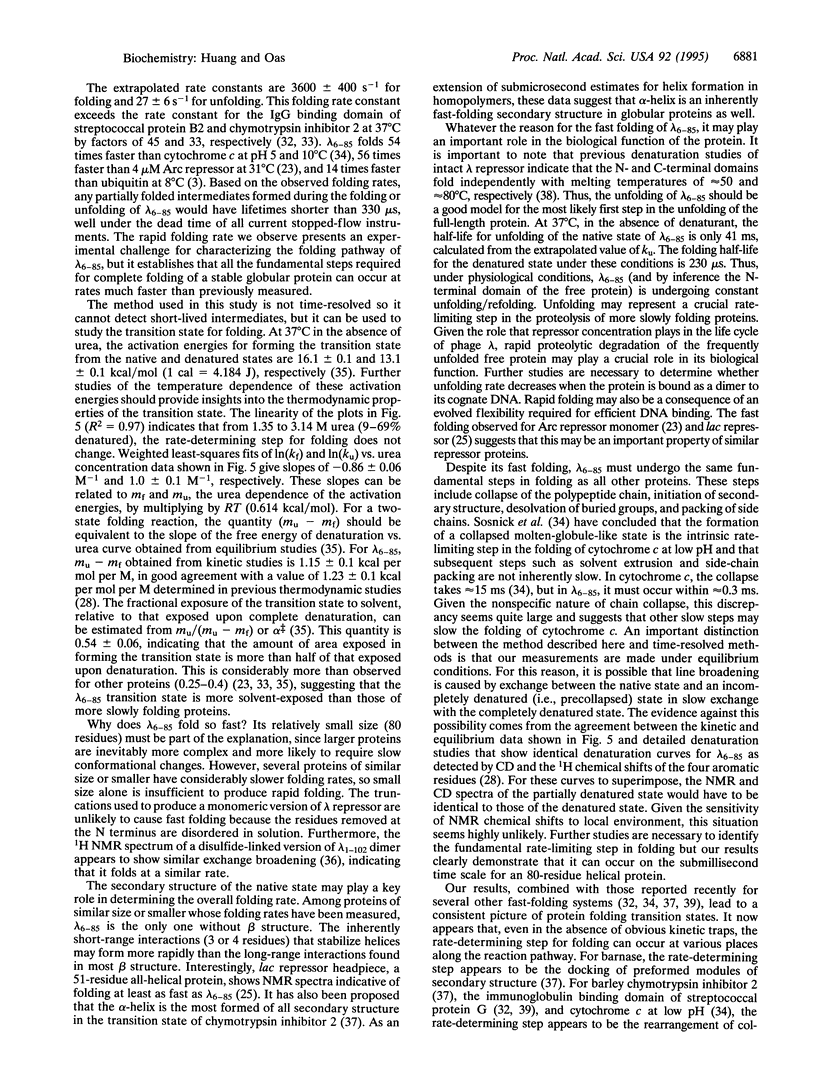
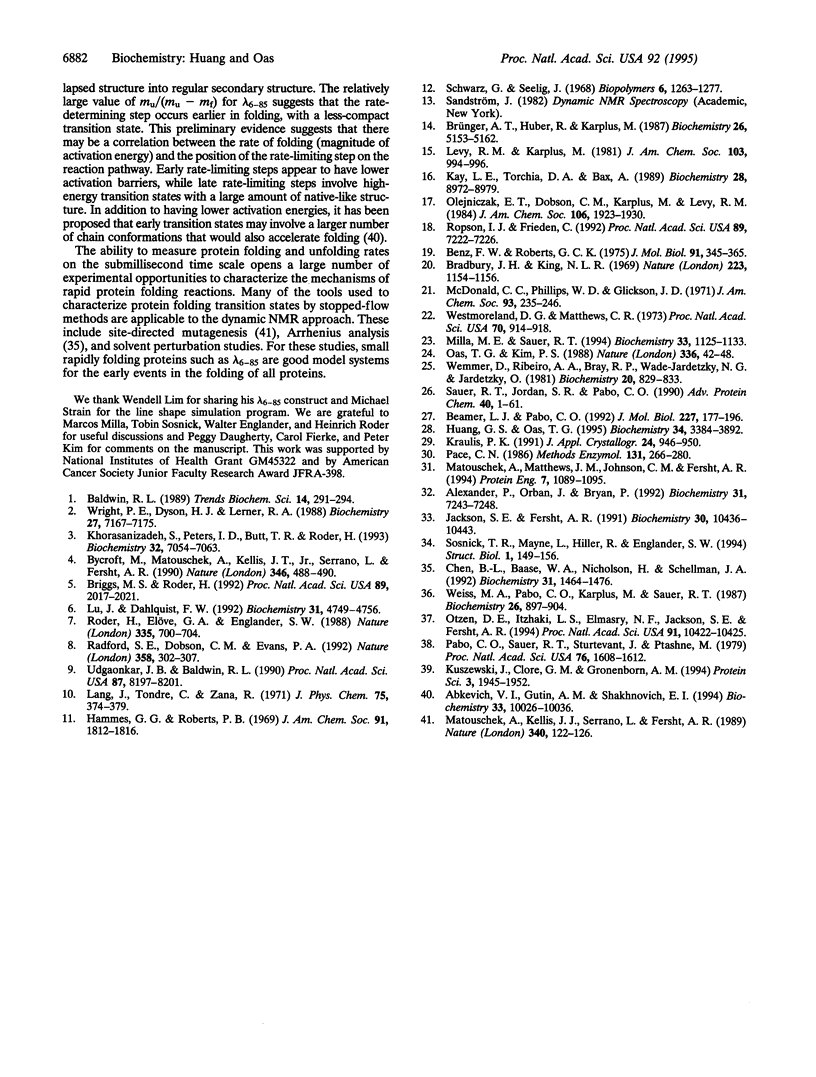
Images in this article
Selected References
These references are in PubMed. This may not be the complete list of references from this article.
- Abkevich V. I., Gutin A. M., Shakhnovich E. I. Specific nucleus as the transition state for protein folding: evidence from the lattice model. Biochemistry. 1994 Aug 23;33(33):10026–10036. doi: 10.1021/bi00199a029. [DOI] [PubMed] [Google Scholar]
- Alexander P., Orban J., Bryan P. Kinetic analysis of folding and unfolding the 56 amino acid IgG-binding domain of streptococcal protein G. Biochemistry. 1992 Aug 18;31(32):7243–7248. doi: 10.1021/bi00147a006. [DOI] [PubMed] [Google Scholar]
- Baldwin R. L. How does protein folding get started? Trends Biochem Sci. 1989 Jul;14(7):291–294. doi: 10.1016/0968-0004(89)90067-4. [DOI] [PubMed] [Google Scholar]
- Beamer L. J., Pabo C. O. Refined 1.8 A crystal structure of the lambda repressor-operator complex. J Mol Biol. 1992 Sep 5;227(1):177–196. doi: 10.1016/0022-2836(92)90690-l. [DOI] [PubMed] [Google Scholar]
- Benz F. W., Roberts G. C. Nucler magnetic resonance studies of the unfolding of pancreatic ribonuclease. J Mol Biol. 1975 Jan 25;91(3):345–365. doi: 10.1016/0022-2836(75)90385-x. [DOI] [PubMed] [Google Scholar]
- Bradbury J. H., King N. L. Denaturation of proteins: single or multiple step process? Nature. 1969 Sep 13;223(5211):1154–1156. doi: 10.1038/2231154a0. [DOI] [PubMed] [Google Scholar]
- Briggs M. S., Roder H. Early hydrogen-bonding events in the folding reaction of ubiquitin. Proc Natl Acad Sci U S A. 1992 Mar 15;89(6):2017–2021. doi: 10.1073/pnas.89.6.2017. [DOI] [PMC free article] [PubMed] [Google Scholar]
- Brünger A. T., Huber R., Karplus M. Trypsinogen-trypsin transition: a molecular dynamics study of induced conformational change in the activation domain. Biochemistry. 1987 Aug 11;26(16):5153–5162. doi: 10.1021/bi00390a039. [DOI] [PubMed] [Google Scholar]
- Bycroft M., Matouschek A., Kellis J. T., Jr, Serrano L., Fersht A. R. Detection and characterization of a folding intermediate in barnase by NMR. Nature. 1990 Aug 2;346(6283):488–490. doi: 10.1038/346488a0. [DOI] [PubMed] [Google Scholar]
- Chen B. L., Baase W. A., Nicholson H., Schellman J. A. Folding kinetics of T4 lysozyme and nine mutants at 12 degrees C. Biochemistry. 1992 Feb 11;31(5):1464–1476. doi: 10.1021/bi00120a025. [DOI] [PubMed] [Google Scholar]
- Hammes G. G., Roberts P. B. Dynamics of the helix--coil transition in poly-L-ornithine. J Am Chem Soc. 1969 Mar 26;91(7):1812–1816. doi: 10.1021/ja01035a036. [DOI] [PubMed] [Google Scholar]
- Huang G. S., Oas T. G. Structure and stability of monomeric lambda repressor: NMR evidence for two-state folding. Biochemistry. 1995 Mar 28;34(12):3884–3892. doi: 10.1021/bi00012a003. [DOI] [PubMed] [Google Scholar]
- Jackson S. E., Fersht A. R. Folding of chymotrypsin inhibitor 2. 2. Influence of proline isomerization on the folding kinetics and thermodynamic characterization of the transition state of folding. Biochemistry. 1991 Oct 29;30(43):10436–10443. doi: 10.1021/bi00107a011. [DOI] [PubMed] [Google Scholar]
- Kay L. E., Torchia D. A., Bax A. Backbone dynamics of proteins as studied by 15N inverse detected heteronuclear NMR spectroscopy: application to staphylococcal nuclease. Biochemistry. 1989 Nov 14;28(23):8972–8979. doi: 10.1021/bi00449a003. [DOI] [PubMed] [Google Scholar]
- Khorasanizadeh S., Peters I. D., Butt T. R., Roder H. Folding and stability of a tryptophan-containing mutant of ubiquitin. Biochemistry. 1993 Jul 13;32(27):7054–7063. doi: 10.1021/bi00078a034. [DOI] [PubMed] [Google Scholar]
- Kuszewski J., Clore G. M., Gronenborn A. M. Fast folding of a prototypic polypeptide: the immunoglobulin binding domain of streptococcal protein G. Protein Sci. 1994 Nov;3(11):1945–1952. doi: 10.1002/pro.5560031106. [DOI] [PMC free article] [PubMed] [Google Scholar]
- Lang J., Tondre C., Zana R. Effect of urea and other organic substances on the ultrasonic absorption of protein solutions. J Phys Chem. 1971 Feb 4;75(3):374–379. doi: 10.1021/j100673a014. [DOI] [PubMed] [Google Scholar]
- Lu J., Dahlquist F. W. Detection and characterization of an early folding intermediate of T4 lysozyme using pulsed hydrogen exchange and two-dimensional NMR. Biochemistry. 1992 May 26;31(20):4749–4756. doi: 10.1021/bi00135a002. [DOI] [PubMed] [Google Scholar]
- Matouschek A., Kellis J. T., Jr, Serrano L., Fersht A. R. Mapping the transition state and pathway of protein folding by protein engineering. Nature. 1989 Jul 13;340(6229):122–126. doi: 10.1038/340122a0. [DOI] [PubMed] [Google Scholar]
- Matouschek A., Matthews J. M., Johnson C. M., Fersht A. R. Extrapolation to water of kinetic and equilibrium data for the unfolding of barnase in urea solutions. Protein Eng. 1994 Sep;7(9):1089–1095. doi: 10.1093/protein/7.9.1089. [DOI] [PubMed] [Google Scholar]
- McDonald C. C., Phillips W. D., Glickson J. D. Nuclear magnetic resonance study of the mechanism of reversible denaturation of lysozyme. J Am Chem Soc. 1971 Jan 13;93(1):235–246. doi: 10.1021/ja00730a039. [DOI] [PubMed] [Google Scholar]
- Milla M. E., Sauer R. T. P22 Arc repressor: folding kinetics of a single-domain, dimeric protein. Biochemistry. 1994 Feb 8;33(5):1125–1133. doi: 10.1021/bi00171a011. [DOI] [PubMed] [Google Scholar]
- Oas T. G., Kim P. S. A peptide model of a protein folding intermediate. Nature. 1988 Nov 3;336(6194):42–48. doi: 10.1038/336042a0. [DOI] [PubMed] [Google Scholar]
- Otzen D. E., Itzhaki L. S., elMasry N. F., Jackson S. E., Fersht A. R. Structure of the transition state for the folding/unfolding of the barley chymotrypsin inhibitor 2 and its implications for mechanisms of protein folding. Proc Natl Acad Sci U S A. 1994 Oct 25;91(22):10422–10425. doi: 10.1073/pnas.91.22.10422. [DOI] [PMC free article] [PubMed] [Google Scholar]
- Pabo C. O., Sauer R. T., Sturtevant J. M., Ptashne M. The lambda repressor contains two domains. Proc Natl Acad Sci U S A. 1979 Apr;76(4):1608–1612. doi: 10.1073/pnas.76.4.1608. [DOI] [PMC free article] [PubMed] [Google Scholar]
- Pace C. N. Determination and analysis of urea and guanidine hydrochloride denaturation curves. Methods Enzymol. 1986;131:266–280. doi: 10.1016/0076-6879(86)31045-0. [DOI] [PubMed] [Google Scholar]
- Radford S. E., Dobson C. M., Evans P. A. The folding of hen lysozyme involves partially structured intermediates and multiple pathways. Nature. 1992 Jul 23;358(6384):302–307. doi: 10.1038/358302a0. [DOI] [PubMed] [Google Scholar]
- Roder H., Elöve G. A., Englander S. W. Structural characterization of folding intermediates in cytochrome c by H-exchange labelling and proton NMR. Nature. 1988 Oct 20;335(6192):700–704. doi: 10.1038/335700a0. [DOI] [PMC free article] [PubMed] [Google Scholar]
- Ropson I. J., Frieden C. Dynamic NMR spectral analysis and protein folding: identification of a highly populated folding intermediate of rat intestinal fatty acid-binding protein by 19F NMR. Proc Natl Acad Sci U S A. 1992 Aug 1;89(15):7222–7226. doi: 10.1073/pnas.89.15.7222. [DOI] [PMC free article] [PubMed] [Google Scholar]
- Sauer R. T., Jordan S. R., Pabo C. O. Lambda repressor: a model system for understanding protein-DNA interactions and protein stability. Adv Protein Chem. 1990;40:1–61. doi: 10.1016/s0065-3233(08)60286-7. [DOI] [PubMed] [Google Scholar]
- Schwarz G., Seelig J. Kinetic properties and the electric field effect of the helix-coil transition of poly(gamma-benzyl L-glutamate) determined from dielectric relaxation measurements. Biopolymers. 1968;6(9):1263–1277. doi: 10.1002/bip.1968.360060904. [DOI] [PubMed] [Google Scholar]
- Sosnick T. R., Mayne L., Hiller R., Englander S. W. The barriers in protein folding. Nat Struct Biol. 1994 Mar;1(3):149–156. doi: 10.1038/nsb0394-149. [DOI] [PubMed] [Google Scholar]
- Udgaonkar J. B., Baldwin R. L. Early folding intermediate of ribonuclease A. Proc Natl Acad Sci U S A. 1990 Nov;87(21):8197–8201. doi: 10.1073/pnas.87.21.8197. [DOI] [PMC free article] [PubMed] [Google Scholar]
- Weiss M. A., Pabo C. O., Karplus M., Sauer R. T. Dimerization of the operator binding domain of phage lambda repressor. Biochemistry. 1987 Feb 10;26(3):897–904. doi: 10.1021/bi00377a034. [DOI] [PubMed] [Google Scholar]
- Wemmer D., Ribeiro A. A., Bray R. P., Wade-Jardetzky N. G., Jardetzky O. High-resolution nuclear magnetic resonance studies of the Lac repressor. 3. Unfolding of the Lac repressor headpiece. Biochemistry. 1981 Feb 17;20(4):829–833. doi: 10.1021/bi00507a027. [DOI] [PubMed] [Google Scholar]
- Westmoreland D. G., Matthews C. R. Nuclear magnetic resonance study of the thermal denaturation of ribonuclease A: implications for multistate behavior at low pH. Proc Natl Acad Sci U S A. 1973 Mar;70(3):914–918. doi: 10.1073/pnas.70.3.914. [DOI] [PMC free article] [PubMed] [Google Scholar]
- Wright P. E., Dyson H. J., Lerner R. A. Conformation of peptide fragments of proteins in aqueous solution: implications for initiation of protein folding. Biochemistry. 1988 Sep 20;27(19):7167–7175. doi: 10.1021/bi00419a001. [DOI] [PubMed] [Google Scholar]



